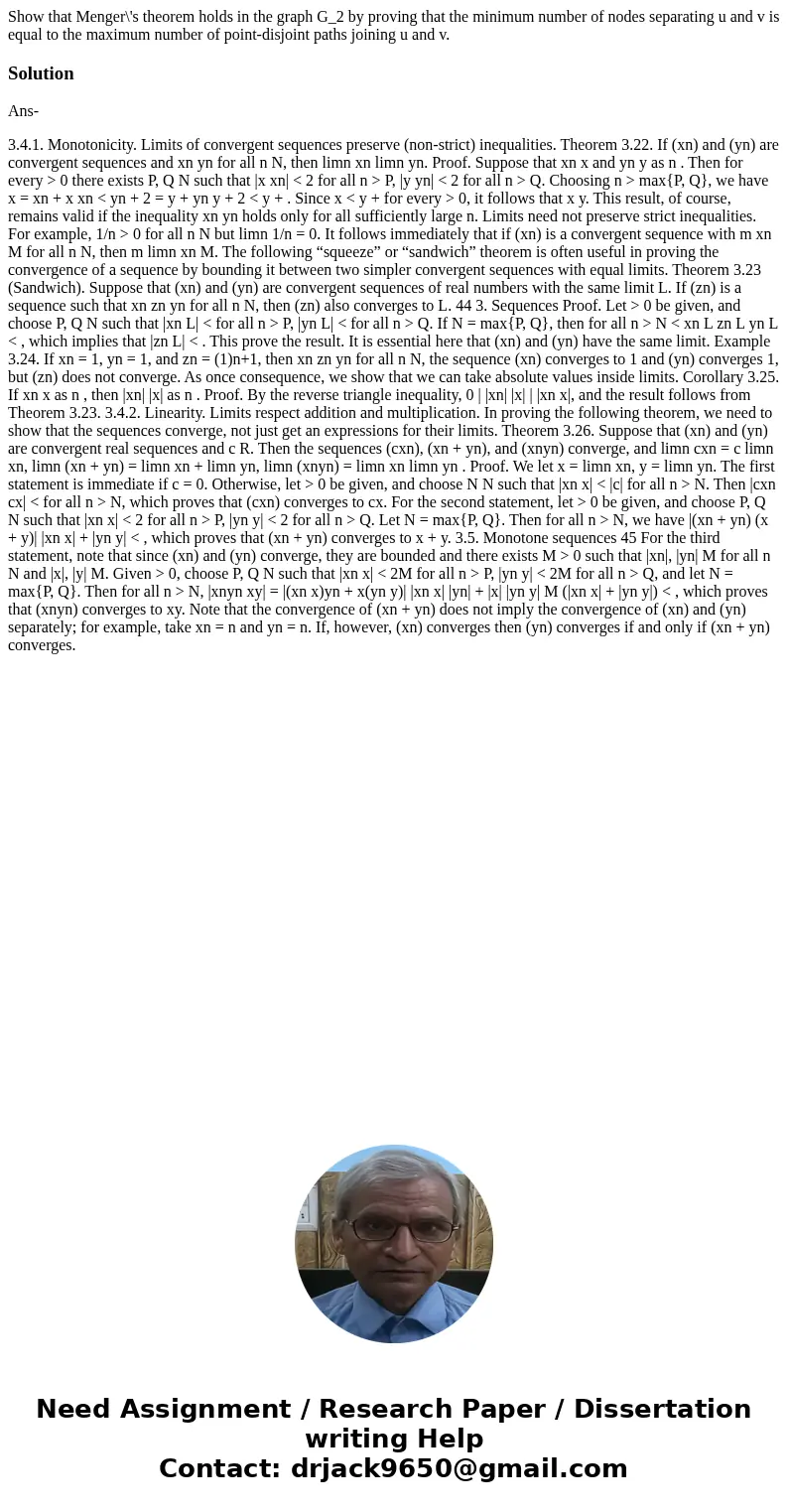Show that Mengers theorem holds in the graph G2 by proving t
Solution
Ans-
3.4.1. Monotonicity. Limits of convergent sequences preserve (non-strict) inequalities. Theorem 3.22. If (xn) and (yn) are convergent sequences and xn yn for all n N, then limn xn limn yn. Proof. Suppose that xn x and yn y as n . Then for every > 0 there exists P, Q N such that |x xn| < 2 for all n > P, |y yn| < 2 for all n > Q. Choosing n > max{P, Q}, we have x = xn + x xn < yn + 2 = y + yn y + 2 < y + . Since x < y + for every > 0, it follows that x y. This result, of course, remains valid if the inequality xn yn holds only for all sufficiently large n. Limits need not preserve strict inequalities. For example, 1/n > 0 for all n N but limn 1/n = 0. It follows immediately that if (xn) is a convergent sequence with m xn M for all n N, then m limn xn M. The following “squeeze” or “sandwich” theorem is often useful in proving the convergence of a sequence by bounding it between two simpler convergent sequences with equal limits. Theorem 3.23 (Sandwich). Suppose that (xn) and (yn) are convergent sequences of real numbers with the same limit L. If (zn) is a sequence such that xn zn yn for all n N, then (zn) also converges to L. 44 3. Sequences Proof. Let > 0 be given, and choose P, Q N such that |xn L| < for all n > P, |yn L| < for all n > Q. If N = max{P, Q}, then for all n > N < xn L zn L yn L < , which implies that |zn L| < . This prove the result. It is essential here that (xn) and (yn) have the same limit. Example 3.24. If xn = 1, yn = 1, and zn = (1)n+1, then xn zn yn for all n N, the sequence (xn) converges to 1 and (yn) converges 1, but (zn) does not converge. As once consequence, we show that we can take absolute values inside limits. Corollary 3.25. If xn x as n , then |xn| |x| as n . Proof. By the reverse triangle inequality, 0 | |xn| |x| | |xn x|, and the result follows from Theorem 3.23. 3.4.2. Linearity. Limits respect addition and multiplication. In proving the following theorem, we need to show that the sequences converge, not just get an expressions for their limits. Theorem 3.26. Suppose that (xn) and (yn) are convergent real sequences and c R. Then the sequences (cxn), (xn + yn), and (xnyn) converge, and limn cxn = c limn xn, limn (xn + yn) = limn xn + limn yn, limn (xnyn) = limn xn limn yn . Proof. We let x = limn xn, y = limn yn. The first statement is immediate if c = 0. Otherwise, let > 0 be given, and choose N N such that |xn x| < |c| for all n > N. Then |cxn cx| < for all n > N, which proves that (cxn) converges to cx. For the second statement, let > 0 be given, and choose P, Q N such that |xn x| < 2 for all n > P, |yn y| < 2 for all n > Q. Let N = max{P, Q}. Then for all n > N, we have |(xn + yn) (x + y)| |xn x| + |yn y| < , which proves that (xn + yn) converges to x + y. 3.5. Monotone sequences 45 For the third statement, note that since (xn) and (yn) converge, they are bounded and there exists M > 0 such that |xn|, |yn| M for all n N and |x|, |y| M. Given > 0, choose P, Q N such that |xn x| < 2M for all n > P, |yn y| < 2M for all n > Q, and let N = max{P, Q}. Then for all n > N, |xnyn xy| = |(xn x)yn + x(yn y)| |xn x| |yn| + |x| |yn y| M (|xn x| + |yn y|) < , which proves that (xnyn) converges to xy. Note that the convergence of (xn + yn) does not imply the convergence of (xn) and (yn) separately; for example, take xn = n and yn = n. If, however, (xn) converges then (yn) converges if and only if (xn + yn) converges.

 Homework Sourse
Homework Sourse